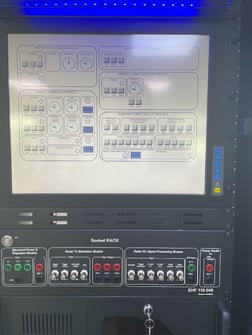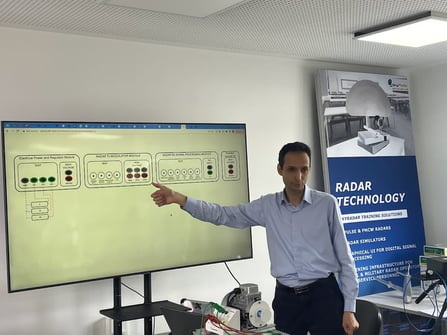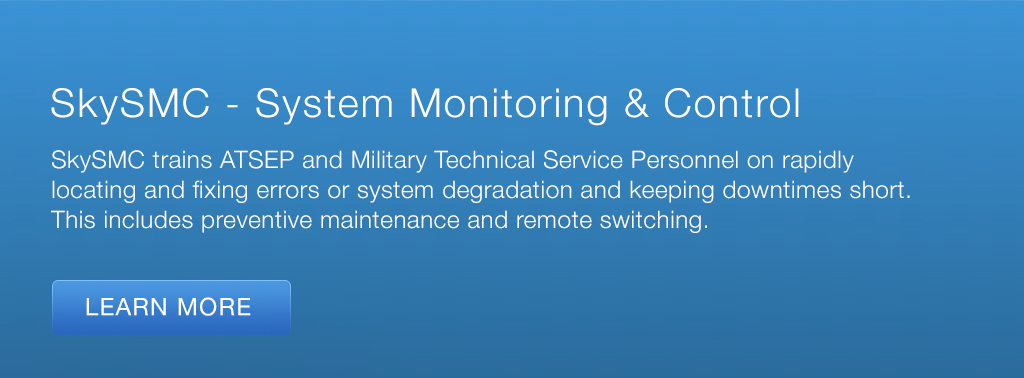Processing errors due to code validation refer to the mistakes or discrepancies that occur during the validation of software codes in air traffic control (ATC) systems. Code validation is a crucial process in ATC, as it ensures that the software codes used in the system are free of errors and can perform their intended functions correctly. However, errors can occur during this process, leading to significant impacts on ATC operations.
Code Validation in ATSEP and Air Traffic Control Service
ATSEP (Air Traffic Safety Electronics Personnel) are responsible for the development, installation, maintenance, and repair of the electronic systems used in ATC. Code validation is a critical part of their job, as they need to ensure that the software codes used in ATC systems are free of errors and can perform their intended functions correctly.
For example, a typical ATC system consists of several subsystems, such as communication, navigation, and surveillance. These subsystems use different software codes that need to be validated before installation to ensure they work together seamlessly. If errors occur during code validation, the system may not function correctly, leading to potential safety risks.
Scenarios Illustrating the Impact of processing Errors related to Code Validation on Air Traffic Control Services
Here are two scenarios that illustrate the impact of processing errors related to processing on air traffic control services
Scenario 1 Inaccurate Flight Data Processing
In a busy air traffic control center, the processing system responsible for analyzing flight data encounters a processing error
Scenario
Due to a software glitch in the processing algorithms, the system begins to inaccurately process flight data. The error causes incorrect calculations related to aircraft positions, speeds, and trajectories.
Impact
The impact of this processing error is as follows
Incorrect Separation Management
Air traffic controllers rely on accurate flight data to ensure safe separation between aircraft. However, the processing error results in incorrect separation calculations. Controllers may receive misleading information about the distance or time required for separation, potentially leading to inadequate separation standards and an increased risk of mid-air collisions.
Compromised Traffic Flow Management
Air traffic flow management is essential for maintaining the efficient movement of aircraft. The processing error affects the system's ability to accurately predict and optimize traffic flow. As a result, controllers may face challenges in balancing the arrival and departure rates, leading to congestion, delays, and inefficient use of airspace and resources.
Scenario 2 Delayed and Inconsistent Flight Updates
In another air traffic control center, a processing error causes delays and inconsistencies in the processing of flight updates:
Scenario
The processing system experiences intermittent delays and inconsistencies in processing real-time flight updates. The error may be attributed to hardware malfunctions or issues in data synchronization between different components of the system.
Impact
The impact of this processing error is as follows:
Reduced Situational Awareness: The delayed and inconsistent flight updates hamper the air traffic controllers' ability to maintain real-time situational awareness. They may receive outdated information about flight plans, changes in weather conditions, or unexpected route modifications. This compromises their decision-making processes, increasing the risk of misjudgments and potential safety incidents.
Inefficient Resource Allocation
Effective resource allocation is crucial in air traffic control operations. However, the processing error disrupts the timely processing of flight updates, making it difficult for controllers to allocate resources efficiently. This includes managing airspace sectors, assigning arrival and departure slots, and coordinating ground handling services. Inefficient resource allocation can lead to delays, reduced capacity, and increased workload for both controllers and pilots.
In both scenarios the impact of processing errors related to processing on air traffic control services highlights the criticality of accurate and reliable data analysis in ensuring safe and efficient air traffic management. It emphasizes the need for robust testing, quality assurance, and prompt error resolution to minimize the risk of incidents caused by processing errors
Impact of processing Errors related to Code Validation on Air Traffic Control Services
Processing errors related to code validation can have significant impacts on air traffic control services. Air traffic control relies heavily on computer systems and software to manage and monitor air traffic, so any errors or flaws in the code used by these systems can have serious consequences. Here are some potential impacts:
Safety risks
Processing errors can introduce safety risks by leading to incorrect or incomplete information being displayed to air traffic controllers. This could result in misunderstandings or misinterpretations of aircraft positions, flight plans, or other critical data. Such errors can increase the likelihood of accidents or near-miss incidents.
Flight disruptions
Code validation errors can disrupt the smooth flow of air traffic, causing delays or cancellations of flights. If errors occur in critical systems, such as those used for route planning or collision avoidance, flights may need to be rerouted or grounded until the issues are resolved, leading to significant disruptions in the airspace.
Decreased efficiency
Errors in code validation can undermine the efficiency of air traffic control services. For example, if automated systems responsible for optimizing aircraft sequencing and spacing encounter errors, it can result in inefficient use of airspace and longer flight durations. This can lead to increased fuel consumption, additional costs for airlines, and congestion in the airspace.
Loss of trust
Air traffic control services rely on the trust of both aviation industry stakeholders and the general public. Processing errors related to code validation can erode this trust. If errors repeatedly occur or are not promptly resolved, it can undermine confidence in the reliability and safety of air traffic control systems, leading to negative perceptions of the industry.
Regulatory concerns
Air traffic control services are subject to strict regulatory standards to ensure safety and operational integrity. Code validation errors can raise concerns among regulatory authorities, leading to increased scrutiny, audits, or potential enforcement actions. Compliance with regulations may be compromised if errors persist, potentially resulting in penalties or restrictions on operations.
To mitigate the impact of processing errors related to code validation on air traffic control services, rigorous testing and quality assurance processes are crucial. Regular software updates, system redundancies, and effective monitoring and reporting mechanisms can also help identify and address code-related issues promptly. Additionally, ongoing training and awareness programs for air traffic controllers and technical staff can help them recognize and respond to potential errors effectively.
Steps to be taken by ATSEP in Rectification of Processing Errors related to Code Validation
ATSEP (Air Traffic Safety Electronics Personnel) play a crucial role in maintaining and rectifying processing errors related to code validation in air traffic management systems. Here are the steps that ATSEP can take in the rectification process
Identify the error
ATSEP should first identify the specific processing error related to code validation. This may involve analyzing error messages, system logs, or reports generated by the air traffic management system.
Gather information
Collect all relevant information related to the processing error. This includes details about the specific code or software module involved, system configuration settings, and any recent changes or updates to the system.
Consult documentation
Review the system documentation, including manuals, specifications, and procedures, to understand the expected behavior and requirements for code validation. This will help ATSEP gain a deeper understanding of the error and its potential causes.
Analyze the code
If necessary, ATSEP should examine the relevant code sections or software modules associated with the processing error. This analysis can help identify any coding errors, inconsistencies, or logic flaws that may be causing the issue.
Collaborate with software developers
If the processing error is related to code validation, it may require collaboration with software developers. ATSEP should communicate the issue to the development team, providing them with all the necessary details and information for further investigation and resolution.
Conduct testing
Depending on the severity and impact of the error, ATSEP may need to perform various tests to replicate the issue and validate potential solutions. This can involve test environments, simulations, or test scenarios designed to uncover the root cause and verify the effectiveness of rectification measures.
Implement a solution
Based on the analysis and collaboration with software developers, ATSEP should develop and implement a solution to rectify the processing error related to code validation. This may involve modifying the code, updating system configurations, or applying patches or software updates.
Verify the rectification
After implementing the solution, ATSEP should conduct thorough testing to verify that the processing error has been successfully rectified. This includes monitoring the system's behavior, conducting regression tests, and ensuring that code validation functions as expected.
Document the rectification process
It is crucial to maintain proper documentation throughout the rectification process. ATSEP should record the details of the processing error, the steps taken for rectification, and any lessons learned for future reference.
Communicate the resolution
ATSEP should inform relevant stakeholders, such as air traffic controllers or other ATSEP personnel, about the resolution of the processing error and any necessary instructions or updates they need to be aware of.
Steps to be followed by ATSEP for Preventing Code Validation
ATSEP can take several steps to prevent code validation errors. These include
Code Development Best Practices
Encourage adherence to coding standards and best practices during the development phase. This includes following established coding guidelines, using appropriate naming conventions, and employing consistent code formatting.
Code Reviews
Implement a systematic code review process to identify potential code validation issues. Code reviews involve multiple developers or experts examining the code to detect errors, inconsistencies, or vulnerabilities. This helps in ensuring that code validation is performed correctly.
Unit Testing
Encourage the development and execution of comprehensive unit tests for code validation functions. Unit testing involves creating test cases that specifically target code validation processes and verifying their correctness. This helps in catching errors early in the development lifecycle.
Integration Testing
Conduct integration tests to verify the interactions and compatibility of different modules or components involved in code validation. Integration testing ensures that code validation functions correctly in conjunction with other system components.
Test Environments and Simulations
Create dedicated test environments or simulations that mimic real-world scenarios to validate code functionality and validate code validation processes. This allows for rigorous testing of code validation under various conditions, helping to uncover potential errors or shortcomings.
Configuration Management
Implement robust configuration management practices to keep track of changes made to the system. This includes version control of code, documentation, and system configurations. Proper configuration management helps in ensuring the integrity and consistency of code validation processes.
Change Control and Documentation
Establish a formal change control process that includes documentation for any modifications or updates made to code validation processes. This ensures that changes are properly reviewed, approved, and documented, reducing the risk of introducing errors.
Training and Knowledge Sharing
Provide training programs and knowledge sharing sessions to ATSEP personnel involved in code validation. This helps in enhancing their understanding of code validation principles, best practices, and potential pitfalls, enabling them to prevent errors more effectively.
Monitoring and Auditing
Implement monitoring and auditing mechanisms to track the performance of code validation processes in real-time. This helps in identifying any deviations or anomalies that may indicate potential errors or malfunctions.
Continuous Improvement
Foster a culture of continuous improvement by encouraging feedback and actively seeking opportunities to enhance code validation processes. Regularly evaluate the effectiveness of preventive measures and incorporate lessons learned into future development cycles.
Factors Responsible for Code Validation related Processing Errors
Several factors can contribute to code validation related processing errors. These include:
Human error
Human error can occur during the validation process, such as incorrect data entry or misinterpretation of requirements. These errors can lead to incorrect code validation and potential safety risks.
Lack of validation standards
The lack of standardized validation processes and protocols can contribute to errors during code validation. Without clear guidelines, validation may not be performed consistently, leading to potential errors.
Time pressure
ATSEP may be under pressure to complete code validation quickly, especially during system upgrades or maintenance. This pressure can lead to errors or inadequate validation, leading to potential safety risks.
Complexity of systems
Modern ATC systems are complex and often interconnected, with multiple subsystems and components. Validating codes for these systems can be challenging, and errors can occur if all components are not thoroughly tested.
Some common types of Processing Errors caused by Code Validation
Some common types of processing errors caused by code validation include:
Syntax errors
Syntax errors occur when the code is not written correctly, such as a missing semicolon or parentheses. These errors can cause the code to fail during validation and may lead to potential safety risks.
Logic errors
Logic errors occur when the code performs an unintended function or does not perform its intended function correctly. These errors can cause the system to behave unpredictably and may lead to potential safety risks.
Integration errors
Integration errors occur when subsystems or components of the ATC system do not work together seamlessly. These errors can cause communication issues, delays, or other system malfunctions, leading to potential safety risks.
Research Highlights
False Positives and False Negatives
Code validation tools, such as static analyzers or linters, can produce false positives, indicating potential issues that do not actually exist, or false negatives, failing to detect real problems. Research has focused on reducing false positives and false negatives to improve the accuracy and effectiveness of code validation tools. This involves developing more sophisticated analysis techniques, refining rule sets, and incorporating machine learning and statistical approaches to enhance the precision of error detection.
Scalability and Performance
As codebases grow larger and more complex, code validation techniques face scalability and performance challenges. Processing errors may arise due to limitations in the analysis or verification algorithms, such as exponential time complexity or high memory usage. Researchers have explored novel algorithms, parallel and distributed computing approaches, and optimized data structures to address scalability issues and improve the efficiency of code validation tools.
Integration Challenges
Integrating code validation into the software development workflow seamlessly can be challenging. Processing errors can occur when code validation tools do not integrate well with existing development environments, build systems, or version control systems. Research has focused on developing integrations, plugins, and extensions that facilitate smooth incorporation of code validation techniques into developers' workflows, minimizing disruptions and reducing the chances of processing errors.
Interoperability and Compatibility
Code validation tools need to work effectively with different programming languages, frameworks, libraries, and coding styles. Processing errors can arise when code validation tools fail to handle language-specific features or when there are compatibility issues with specific programming environments. Researchers have investigated techniques for language-agnostic code analysis, cross-language interoperability, and adaptability to different development ecosystems, ensuring reliable code validation across diverse software projects.
Dynamic Code Analysis Overhead
Dynamic code analysis techniques, such as runtime instrumentation or dynamic taint analysis, can introduce performance overhead during code execution. Processing errors may occur when the analysis consumes excessive system resources or slows down the program execution to an impractical extent. Research has focused on reducing the overhead of dynamic code analysis through techniques like just-in-time instrumentation, sampling, or lightweight runtime monitoring, ensuring that the analysis process does not interfere with the program's functionality.
Debugging and Error Reporting
When processing errors occur during code validation, it is essential to provide meaningful feedback and debugging information to developers. Research has focused on improving error reporting mechanisms, providing detailed diagnostics, and offering actionable insights to aid developers in understanding and resolving code validation issues effectively. This includes techniques like traceability analysis, automated bug localization, and visualization tools to enhance the debugging process.
SkyRadar's System Monitoring & Control Solution
SkySMC - SkyRadar’s System Monitoring and Control Suite is a pedagogically enhanced, fully operational monitoring & control tool. It has been designed to practice these use cases. We have optimized it to host ATSEP training in SUR, NAV, COM, DPR and SMC compliant to EASA's Easy Access Rules for ATM-ANS (Regulation (EU) 2017/373) and ICAO Doc 10057.
SkyRadar provides SkySMC as a complete laboratory in a turn-key approach, or as a virtual infrastructure (for purchase or as a service).
SkySMC is not a simulator, but a fully operational open monitoring system. It comes by default with a server including various virtualized applications and virtualized servers, but also connects to simulated systems. In addition, there are various hardware extensions available including training infrastructures, monitorable training radars, or even complete ATM systems, all connected to the System Monitoring & Control solution. Most components such as the radars, it IT infrastructure or networks exist in hardware and software (virtualized or simulated).
The two photos above show the same trouble-shooting panel and socket rack in real hardware and in the simulator (fully functioning).
SkyRadar's System Monitoring & Control training system can be easily blended into distance learning solutions and existing learning management systems.
Let's talk
Stay tuned to be always the first to learn about new use cases and training solutions in ATSEP qualification (real radars or simulators).
Or simply talk to us to discuss your training solution.
References
-
International Civil Aviation Organization (ICAO). (2011). Annex 11: Air Traffic Services. Montreal: International Civil Aviation Organization.
-
European Organisation for the Safety of Air Navigation (EUROCONTROL). (2015). Safety Nets in Air Traffic Management. Brussels: EUROCONTROL.
-
Federal Aviation Administration (FAA). (2016). FAA Order 7110.65U: Air Traffic Control. Washington, DC: Federal Aviation Administration.
-
Aeronautical Information Management (AIM) Team. (2013). Code Validation in the Aeronautical Information Management System. Montreal: International Civil Aviation Organization.






